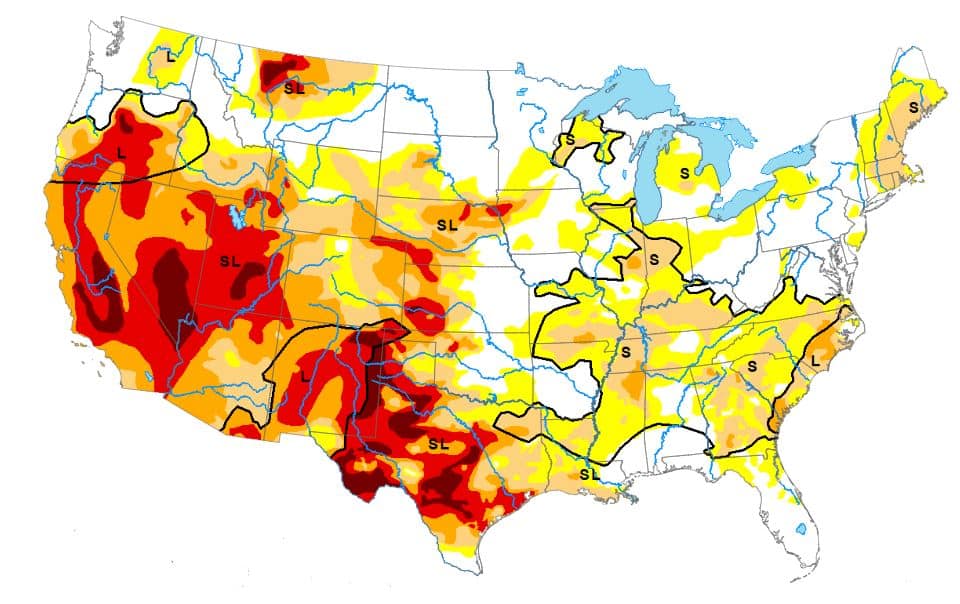Last updated on October 5th, 2023 at 10:05 am
Check your drought plan. It may be time for some tough decisions.
One glance at the drought monitor map tells the tale. A big chunk of cattle country is once again in the grip of severe drought.
But if you’re at ground central on the map, you already know that.
And that means it’s time to look at your drought plan. As summer rolls on and drought conditions worsen, here are some suggested immediate critical steps to take:

Identify Critical Dates and Target Conditions
These are your critical dates for implementing different phases of your drought management plan. Work with Extension, NRCS, and your team to identify the earliest possible indicators of forage deficits.
“Many semiarid rangelands are composed of mixtures of cool and warm-season species. Consequently, it is often helpful to select two or more critical dates when most species of each growth-season category have headed to evaluate the contribution of each component to total herbage production,” according to the National Drought Mitigation Center (NMDC).
Monitor Your Resources
This is where horse hooves, ATV tires, and boots hit the ground. Using your critical dates as hard stops, scout your pastures so you know what’s happening on the ground. If you can, maintain precipitation and grazing records for each pasture each year, Greenfield suggests.
Here’s an idea of what you’re looking for, according to NDMC:
- Monitor precipitation and forage availability on critical dates or more frequently.
- Monitor residual forage after moving animals out of pasture, and keep grazing records throughout the season as animals are moved.
- Monitor livestock gain and body condition at critical intervals in production cycle, and monitor livestock markets as needed to meet ranch objectives.
- Range condition, including scouting for indicator species and assessing hydrologic condition of rangeland, should be monitored annually, along with water resources and financial health.”
Culling Advice
Among the mid-summer decisions are which cattle to cull, says Adele Harty, South Dakota State University cow-calf field specialist. First, however, take an inventory of available feed resources and costs, she adds.
“Once the feed inventory is known, then the culling criteria for making culling decisions can be developed. As these criteria are being developed, focus on the mission and vision of your operation,” she says. “What are your core values and what are your most important priorities? Ensure your culling criteria is in line with your mission and values.”
With your core values in mind, evaluate your cow herd and decide which animals will help you reach your goals and which are limiting you.
That will help you make your cull-keep decisions. Ultimately, however, how many to cull depends on your forage and feed resources, says Ashley Kettner, R&D research coordinator with Riomax®.
Getting More Grazing Days
“Better-using the land that you have is so important during a drought,” she says. “We all know that during a drought, supply and demand take a hard hit. The supply of hay and other forages goes down, the demand increases, and prices skyrocket.”
So even if your pastures are dry and crinkly, you can still utilize the forage that’s there. You’ll certainly want to adjust stocking rate and monitor pastures so they aren’t overgrazed, but then you can use supplements to ensure more even grazing, says Kettner, a 6th generation cow-calf producer who ranches with her husband in Minnesota.
“Strategically moving and placing supplement tubs means we’re enabling those cows to graze parts of the pasture that they would not typically graze and help them frequent parts of the ranch that they would not typically frequent,” she says. “This means less dependence on hay and supplements you would have to buy.”
“Using a temporary electric fence to cross-fence can increase utilization, slowing down the grazing rotation and stretching forage considerably,” says Ben Beckman, Nebraska Extension educator.

“This is especially true when plants become dormant due to lack of precipitation or heat,” he says. “Typically, utilization seeks to balance animal demand and plant health, but taking more of a dormant plant without damaging the crown has little impact on overall plant health.”


